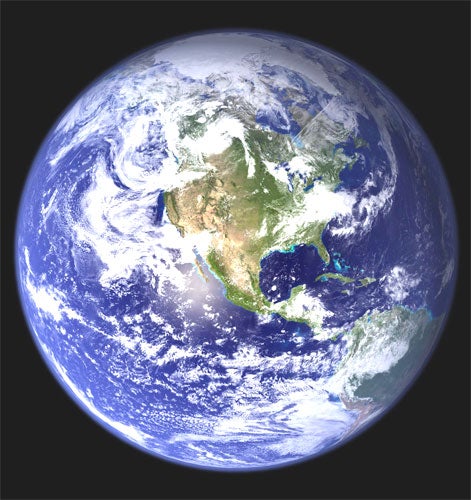Nasa image shows it's a wonderful world
Extraordinary composite picture taken over many months shows Earth in incredible detail

Your support helps us to tell the story
From reproductive rights to climate change to Big Tech, The Independent is on the ground when the story is developing. Whether it's investigating the financials of Elon Musk's pro-Trump PAC or producing our latest documentary, 'The A Word', which shines a light on the American women fighting for reproductive rights, we know how important it is to parse out the facts from the messaging.
At such a critical moment in US history, we need reporters on the ground. Your donation allows us to keep sending journalists to speak to both sides of the story.
The Independent is trusted by Americans across the entire political spectrum. And unlike many other quality news outlets, we choose not to lock Americans out of our reporting and analysis with paywalls. We believe quality journalism should be available to everyone, paid for by those who can afford it.
Your support makes all the difference.This spectacular image of the Earth is the most detailed, true-colour picture of the planet ever taken from space. It was made from many different images collected by Nasa satellites and put together as a composite photograph.
It shows the "blue marble" beauty of our home planet and was produced by a team of scientists using months of satellite observations of the land, oceans, sea ice and clouds, covering every square kilometre of the Earth's surface. The wafer-thin atmosphere on which all life depends can just be discerned as a brilliant blue glow on the western horizon, while the vast expanse of blue ocean illustrates that the Earth is truly a water world.
Click here to view a large version of the image
The first images of the Earth taken from space – by the Apollo 8 mission to orbit the Moon – created a universal sense of awe when they were published in 1969. They forever changed our view of the planet and helped launch the environmental movement, as they depicted the apparent vulnerability of our only life-support system.
Much of the data on which this latest image is based was collected by Nasa's Moderate Resolution Imaging Spectroradiometer (Modis), a remote-sensing instrument flying more than 700km above Earth on the Terra satellite.
A Nasa spokesman said that views showing North America and the Indian Ocean have been downloaded more than a quarter of a million times in the past couple of days.
In another famous image of Earth, taken in 1990 by the Voyager 1 spacecraft at a distance of some 3.7 billion miles, the Earth appeared as a "pale blue dot" surrounded by the vastness of space, like a tiny mote of dust caught in a sunbeam.
When the late Carl Sagan, a renowned American astronomer and science writer, first saw this image he was inspired to write these words: "Look again at that dot. That's here. That's home. On it everyone you love, everyone you know, everyone you ever heard of, every human being who ever was, lived out their lives."
Join our commenting forum
Join thought-provoking conversations, follow other Independent readers and see their replies
Comments